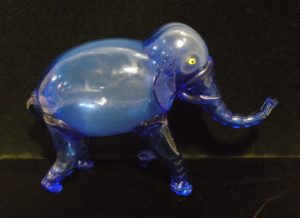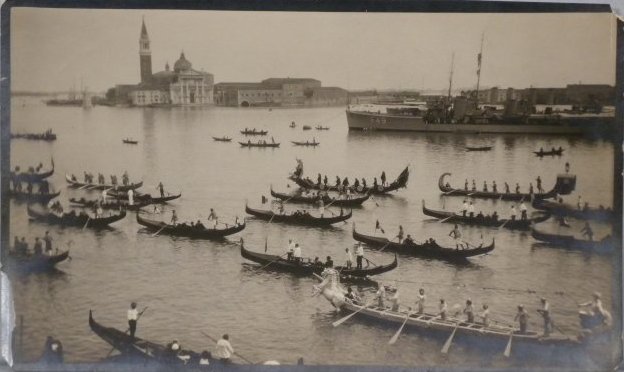 Today we profile a blown glass elephant on view in the museum’s Decorative Arts gallery. The blue elephant is a favorite of visitors, especially children, and comes from one of our largest collections of art, donated to the university in the 1930s by Louis B. and Eleanor Audigier.
Today we profile a blown glass elephant on view in the museum’s Decorative Arts gallery. The blue elephant is a favorite of visitors, especially children, and comes from one of our largest collections of art, donated to the university in the 1930s by Louis B. and Eleanor Audigier.
The elephant is made of Murano glass––blown glass made on the island of Murano, just off the coast of the northern Italian city of Venice. Glass has been made in the Venice area for over 1,500 years. Venice was an important trading port, and glassmaking techniques were introduced by Syrian glassblowers in the Middle Ages.
By the 15th and 16th centuries, Murano, Italy was Europe’s glassmaking center. While Murano glass diminished in popularity as glassmaking techniques spread across Europe, Murano and Venetian glass saw a revival in the 19th century as European and American designers and scholars praised the laborious art of glassblowing and condemned mass manufactured factory glass.
It was around the same time that middle and upper-class Americans were able to come to Europe––the steam ship made their own “Grand Tour” of the continent possible. Victorian tourists (perhaps even more than today’s tourist) demanded knickknacks as proof of their travels and their sophisticated taste. Late 19th century tourists began taking boats over to the island to see glass blowing demonstrations. A skilled glassmaker creatively formed this stylized elephant from over twelve parts of free blown molten glass and fused them together.

Grand Canal Gondola Procession, Venice, Italy, 1920, Photo by Louis B. Audigier, 1934.1.AU.153.
The Audigiers were typical examples of this type of turn of the century tourist. Louis was a newspaperman and lecturer and Eleanor led the Nicholson Art League (1906–1923)—a club for both artists and patrons that sponsored art lectures and exhibits. The Audigiers left Knoxville around 1911 to travel, and spent almost 25 years as residents of Italy, where Louis was a photographic correspondent for the New York Times. Much of the art they donated to the museum comes from their time living and traveling throughout Italy. Several pieces of their Venetian glass collection are now on display in the gallery, and in our collections. To learn more about Murano glass, and to see a brief glass blowing demo, watch the video below.
The Audigiers were
